
by Joe Mock
All rights reserved on images and text
I was given an exclusive tour of Globe Life Field, the future home of the Texas Rangers, so that I could take a lot of photos and get a really good idea of what the finished stadium was going to look like. If the facility’s name sounds familiar, that’s because the same insurance company owns the naming rights on the Rangers’ just-vacated home, Globe Life Park.
The new field is scheduled to host its first game on March 23, 2020 when the Rangers play an exhibition against the Cardinals. The regular-season opener will be March 31 against the Angels. According to Manhattan, the construction manager, everything is on schedule.
Globe Life Field’s street address is 734 Stadium Drive. The “7” is a tribute to Hall Of Fame catcher Pudge Rodriguez and the “34” is a nod to The Ryan Express, Nolan Ryan. This is just a block and a half from the southwest corner of the former park. A quarter mile to the west is AT&T Stadium, the home of the Dallas Cowboys. For years, the land on which the new park is being constructed contained parking lots, used for both baseball and football.
Building a new baseball facility wasn’t the only thing on the Rangers’ agenda, though. The land between the old and new ballparks now contains Texas Live! (yes, the exclamation mark is officially part of the name), an entertainment complex containing high-energy restaurants, bars and music venues … plus the $150-million Live! by Loews, a spectacular 300-room luxury hotel that opened August 22, 2019. We’ll provide more on these venues after we examine the construction that is happening on the new ballpark.
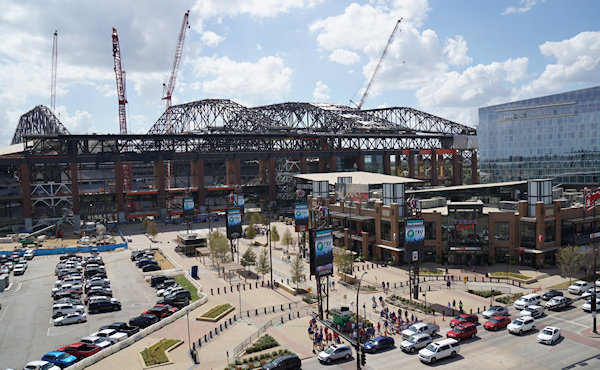
For two seasons, fans attending Rangers games have flocked to the upper concourse down the first-base line in Globe Life Park. There they had the best view of the construction site. And on the day of the final Rangers contest at the old park, the view above is what the fans saw. The Loews hotel is on the far right, and in front of it is the Texas Live! complex, much of which has been open for the past year.
My tour guides were from HKS, the architecture firm that designed this park — and who had a big hand in Globe Life Park back in the early ’90s. It’s also noteworthy that they were the architects on AT&T Stadium.
Representing HKS were Thomas Smith, VP of the Sports & Entertainment Group, and Principals Greg Whittemore and Fred Ortiz. Before we entered the structure, we stopped to discuss the mammoth trusses that will form the retractable roof, certainly the most noticeable feature of the stadium.
As the panels open at other retractable-roof parks, they stack on top of each other — making the overall structure incredibly tall. Here, the plans call for the trusses to be joined together once they have all been hoisted into place, making one enormous (relatively flat) roof panel. This will avoid the top-heavy look of, say, the parks in Seattle or Houston. And unlike Chase Field in Phoenix, where the panels open over the middle of the playing field and slide apart going in opposite directions, the entirety of the movable roof in Arlington slides one way — to the west. This means that the parallel tracks on which the roof will move extend very far out from the main structure on the west side. Like in Miami, that will create a large shaded area on the exterior of Globe Life Field that will form a very nice entry plaza.
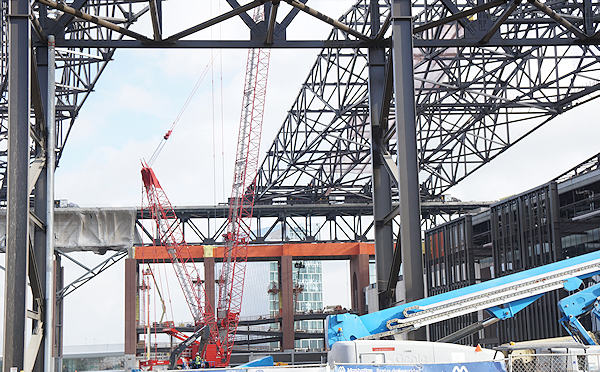
A few factoids for you regarding the roof: the trusses are 675′ across, meaning the parallel tracks that will allow the roof to move are about 650′ apart; each of those tracks is about 900′ long; the finished roof will weigh in the neighborhood of 40 million pounds and cover an area of seven acres. Wow.
We ventured into the construction site directly behind home plate. The concourses are very wide and have a number of interesting features like 360-degree bars. There’s no doubt that there will be lots for fans to explore.
And this is the first view of the playing field — filled to the brim with cranes and construction materials.
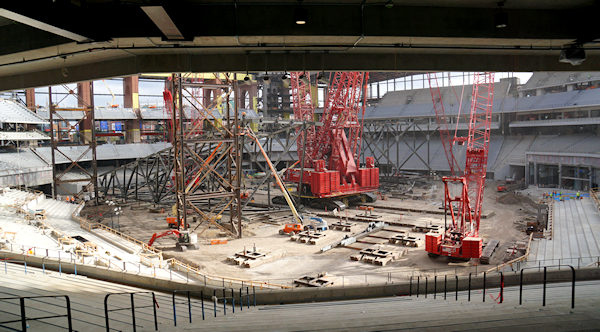
When I interviewed Chuck Morgan, the longtime PA announcer for the Rangers, for an article about the closing of Globe Life Park, he told me about a memory from his youth. “Back in the day when I was a kid going to Sportsman’s Park (in St. Louis), announcer Charlie Jones was right behind the plate,” he recalled. “Back before everything was electrified, the PA guy would get on the field and announce the changes to the crowd through a megaphone.”
In a meeting with HKS’s designers, Morgan told them this story, and a discussion ensued about where the PA announcer’s booth should be located in the new park. “So they’ve put me right behind home plate on the main concourse in what I call a ‘Pope Bubble.’ People (on the concourse) can see inside, and I’ll be able to shake hands with the fans.”
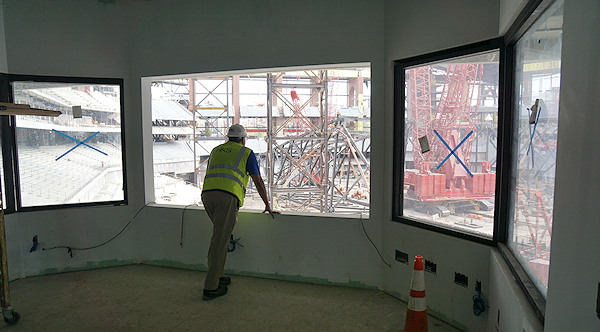
Morgan’s Pope Bubble will be two levels below the pressbox and the rest of the production personnel. And it’s arguably the best vantage point in the ballpark.
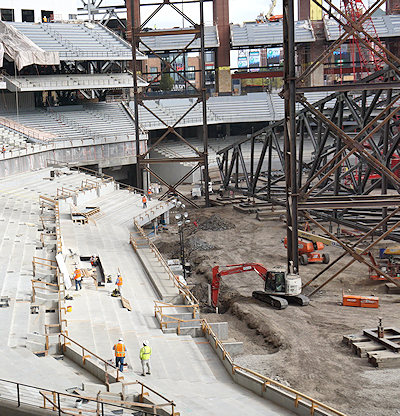 In this photo, you can see that the areas near the dugouts are being excavated. Surrounding them will be Dugout Clubs that will be as close to the action as you can possibly be. These clubs will face the field, although their floors will actually be lower than the level of the field. These premium clubs, along with the Homeplate Club, are located in the Service Level, directly adjacent to the Rangers’ and visitors’ clubhouses.
In this photo, you can see that the areas near the dugouts are being excavated. Surrounding them will be Dugout Clubs that will be as close to the action as you can possibly be. These clubs will face the field, although their floors will actually be lower than the level of the field. These premium clubs, along with the Homeplate Club, are located in the Service Level, directly adjacent to the Rangers’ and visitors’ clubhouses.
Speaking of excavation, the playing surface is anywhere from 50′ to 75′ below street level, as the land surrounding the park isn’t level. Removing that much dirt is no small feat. “Every day for six months, the construction crews were excavating the site,” Smith remarked. “At its peak, there were 1,000 truckloads of dirt being removed from here per day.”
And if there is an unmistakable trend in sports-facility design in recent years, it’s social gathering spaces. “The sport is very social,” remarked Ortiz. “We’re here (at a game) with our family and friends, and that’s what matters. The more social a venue can become the better.”
One huge example of this is a “marketplace” on the main concourse behind third base (below). One imagines it will be somewhat like the food court behind home plate in Globe Life Park, but on a much, much larger scale. This space will be made “flexible” so it can accommodate different kinds of groups and events. Further, movable doors can allow this area to open up to the patio underneath the retractable roof when it’s in the open position.

An area that will attract a large number of fans next spring is the upper level high above left field. The view of the seating bowl and playing field is spectacular. In the meantime, you’ll have to imagine it without the cranes.
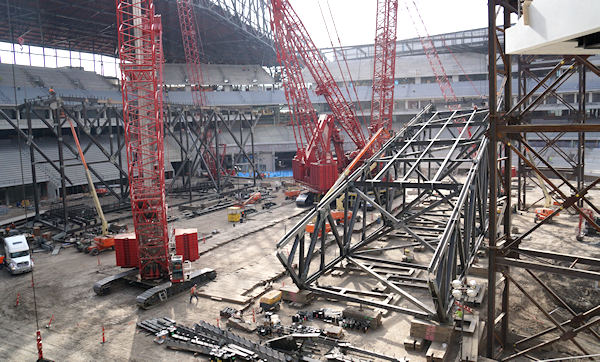
The red crane, by the way, is the largest American-made crane currently in use. Once the roof panels have been hoisted into place, it will be time for the Manitowoc 31000 crane to be dismantled and removed — and it will take 140 truckloads. Then the playing surface — which will be artificial — can be installed.
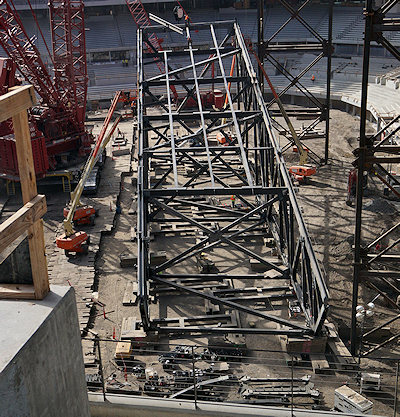 I asked the HKS guys about the design of the retractable roof panel (one of its truss sections is being assembled in this shot) and the orientation of the park. I’d read that everything had been done so that when the roof was open, sunlight would hit all corners of the field so natural grass would grow. “Yes, the design team spent an inordinate amount of time working towards the ideal orientation of the field and the optimal aperture required to maximize sun exposure on the grass,” Whittemore remarked. So I then asked the obvious question: Would it have saved a lot of trouble if you’d known all along that the playing surface was going to be artificial? “Ab-so-lutely,” he replied with a chuckle. “But now when the roof is open, the fans will be able to enjoy the game outside.”
I asked the HKS guys about the design of the retractable roof panel (one of its truss sections is being assembled in this shot) and the orientation of the park. I’d read that everything had been done so that when the roof was open, sunlight would hit all corners of the field so natural grass would grow. “Yes, the design team spent an inordinate amount of time working towards the ideal orientation of the field and the optimal aperture required to maximize sun exposure on the grass,” Whittemore remarked. So I then asked the obvious question: Would it have saved a lot of trouble if you’d known all along that the playing surface was going to be artificial? “Ab-so-lutely,” he replied with a chuckle. “But now when the roof is open, the fans will be able to enjoy the game outside.”
The roof panel is surprisingly sophisticated. When the roof is closed, there will still be natural light coming through. Not with blinding patches on the playing surface like at Chase Field in Phoenix, but with diffused light though panels made of a polymer called ETFE. In case you’re curious, that’s short for ethylene tetrafluoroethylene.
HKS did a tremendous amount of research on these panels, resulting in portions that will be translucent, and other areas that will be opaque. This will permit natural light to reach the stands on the third-base side, but the opaque areas on the panels will prevent the fielders from losing a fly ball when they look up at the panels on a sunny afternoon. Ingenious. The opaque areas of the ETFE panels “block all direct light from noon until dusk,” explains Smith. The clear areas of the panels “allow for indirect light to enter the space and lighten up an area that is traditionally dark and cavernous in other domed stadiums and ballparks.”
While we were on the upper level in left field, we discussed the gorgeous arches that frame the concourse connecting the area behind third base with center field (below). Ortiz said that the original thinking was for these arches to be side by side forming the exterior of the north face of the ballpark. Orienting them like this, though, is brilliant.
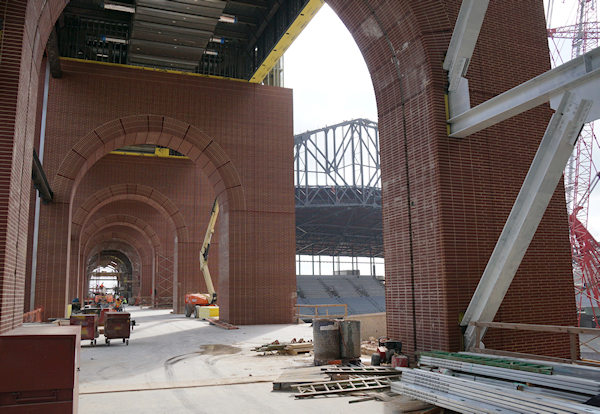
The location of this arched walkway reminds me of the concourse in Houston’s ballpark that runs from the left-field corner to center field — but the two concourses are similar only in location. The one in Houston is far too cramped, while this walkway is positively grand, both in aesthetics and spaciousness. I think these arches will become a landmark feature of Globe Life Field. Ortiz commented that the look of this side of Globe Life Field is a “nod” to Globe Life Park, as the Rangers’ former home also has beautiful arches and columns.
While walking along this arch-enhanced concourse, you’ll be able to look to your left and see the Rangers’ previous home as well as the rooftops and concert space of Texas Live! (below). It should be noted that Globe Life Park will not be demolished. Instead, artificial turf will be installed and its seating bowl will be modified to accommodate football. That’s because the Dallas Renegades of the XFL will be calling the lovely stadium home. It’s nice to see that it will be kept around and re-purposed.
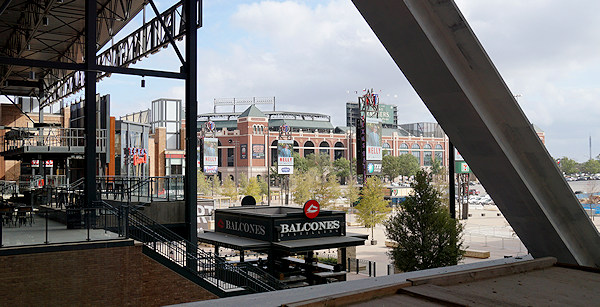
At the west end of this concourse (closest to AT&T Stadium) is a plaza that overlooks the large area that will be covered by the retractable roof when they’re playing open-air baseball (below). The southeast, southwest and northeast entries will also have large external shade features, which will no doubt delight Rangers fans who have been baked while waiting in line to enter Globe Life Park. Ortiz referred to these areas as “Texas-sized porches that are very welcoming to the fans.”
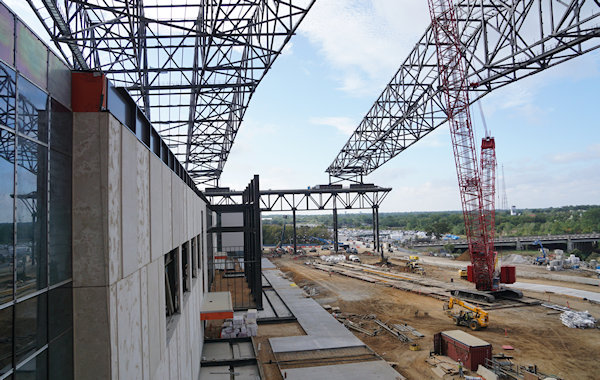
It’s noteworthy that AT&T Stadium also has a retractable roof, but “we thought the new ballpark roof should not mimic AT&T Stadium’s curved roof, but have its own identity and resonate with simple roof forms defining the Texas landscape,” Ortiz points out. Indeed, no curving roof panels or tracks here.
Whittemore quickly adds that “the Texas Rangers brand is very different than the Cowboys’ brand, and we wanted this new park to reflect that.”

In addition to the clubs that are at — or actually below — the level of the playing field, there is a ring of conventional luxury suites between the lower seating bowl and the upper decks. The view above is from the seating space in front of one of those. This one is roughly behind the first-base on-deck circle.
The upper levels of seats are reminiscent of Nationals Park (Washington) or Citizens Bank Park (Philadelphia), in that the uppermost rows of seats are actually above the upper concourse, with a gap between the upper upper deck and the lower upper deck. This makes for somewhat of an open concourse.

The area behind the upper-level seats down the first-base line (above) utilizes some fascinating geometry. There are large openings to the levels below, much like the area behind home plate at San Diego’s Petco Park.
In the photo above, the team offices will be located just to the right of the concourse from which I took the shot.
While the new stadium is the crown jewel of the new construction, don’t forget that there will be lots to do before and after games at the Texas Live! complex and the adjacent Live! By Loews hotel.

The shot above was taken from East Randol Mill Road, looking south. To the left is Troy’s (as in Hall of Fame quarterback Troy Aikman), which is the northernmost establishment at Texas Live!, and to the right is the Live! by Loews hotel. In the distance you can see the north-facing wall of the new ballpark, with one of its unfinished roof trusses on top.
In addition to the gourmet food and cocktails in Troy’s, Texas Live! also features Guy Fieri’s Taco Joint, Lockhart Smokehouse BBQ, and Pudge’s Pizza.
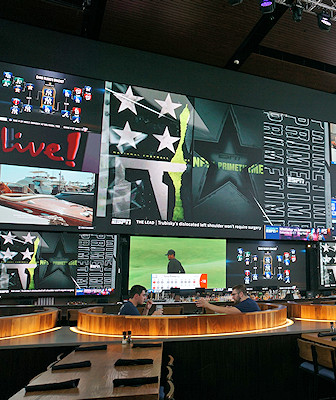 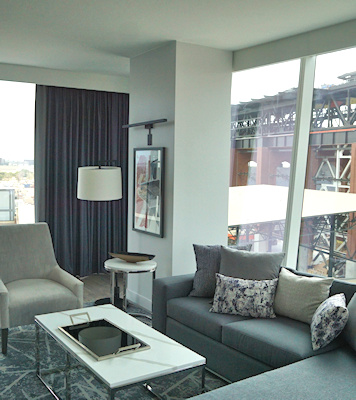 |
In the center is the Live! Arena with wall-to-wall sports and entertainment (shown above), and on Saturday nights it turns into a high-energy nightclub. You’ll also find two levels of food, drink, bowling and games at Sports & Social Arlington and an outdoor concert venue called Arlington Backyard that can hold 5,000 people.
Not to be outdone is the incredibly impressive hotel operated by Loews and designed by the hospitality division of HKS. Gorgeous on the outside and with 300 luxury guestrooms and upscale restaurants and bars on the inside, it’s a destination in and of itself. The rooms offer tremendous views of the new ballpark (like above), the old park, AT&T Stadium and Texas Live!. In all of the hallways and rooms you’ll find unique art, much of it with a baseball theme.
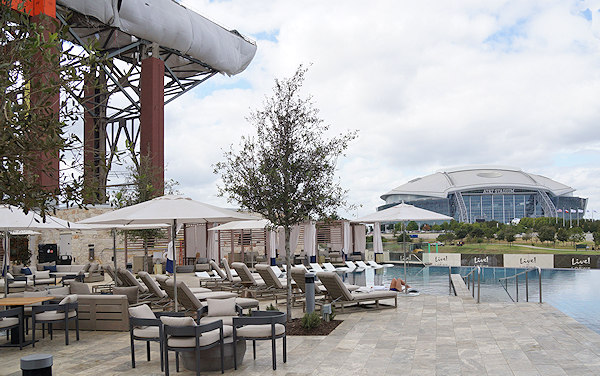
The pool and outdoor plaza at the hotel certainly offer features that aren’t found elsewhere. There is a swim-up bar and a two-sided video board if you’d rather watch the baseball or football game while relaxing in the pool. And guests will love the iconic views of the two stadiums.
For years, Arlington has been the entertainment hub for the Dallas-Fort Worth area, since it features the Hurricane Harbor water park, Six Flags theme park, the Rangers, the Cowboys, convention space … and now there’s a new e-sports venue just north of the old ballpark, and the National Medal of Honor Museum that will open in 2024. When you combine all of this with Texas Live!, Live! by Loews and most of all, Globe Life Field, you have an entertain mecca that is arguably unrivaled in the U.S.
I can’t thank my exceptional tour guides enough for spending the morning showing me every nook and cranny at the gargantuan construction site, and afterwards explaining the engineering behind how everything works. From left are Fred Ortiz, Thomas Smith and Greg Whittemore. I can’t wait for them to show me the finished product in March, because it’s shaping up to be one of the best facilities in Major League Baseball.
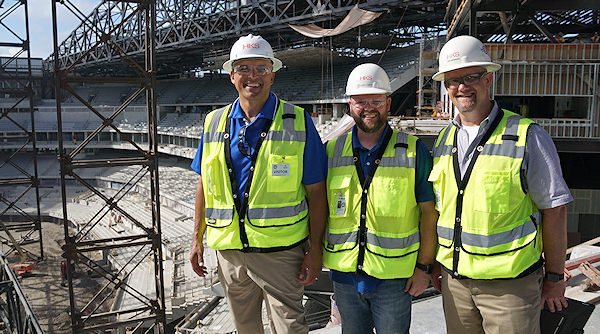
How does the actual playing field compare to what we had at GLP. The new one looks really small.
Supposedly, the amount of fair territory will be comparable. The Rangers haven’t released what the exact dimensions will be yet, though, so we can’t do any exact calculations, but I don’t think the playing field will be much — if any — smaller.
This is amazing! Did they say what they are going to do with the batters eye in center field? Also just curious to see what other features they will have at the ballpark to make it iconic? I.E. Ivy on the walls at wrigley, fountains at kaufman, green monster at fenway?
Great article!!
Thanks for the kind words. This piece was a lot of fun to do, because I enjoyed the tour immensely. The batter’s eye is supposed to be vertical and dark green, but now that the playing surface is going to be artificial, I don’t think they’ll be configuring the roof panels to shine enough light on the outfield to get ivy to grow. That’s just my guess. As far as an iconic element, don’t you think the air condition will be iconic enough?? HA! Anyway, I think it will be the beautiful arches high above left field. They are stunning.
Makes sense! I’m curious to see if they’ll do the usual home run fireworks? So excited, that i watch the stadium go up brick by brick on the webcam everyday!
You know Chuck Morgan is in charge of everything related to music, fireworks, between-innings events, etc. When I interviewed him, he assured me that Ranger fans will still feel like they’re at a Rangers game in the new park, with much of the same treatment (Cotton Eyed Joe, Deep In The Heart of Texas, what goes on between innings) as at GLP. He didn’t say the fireworks would be the same, but you’d have to assume they will be similar, taking into account that the roof will closed a lot.
Great article Joe. I live in Dallas and go to many Ranger games. I’ve been out to Texas Live! many times and kept an eye on the project. Your piece had a lot of information that I hadn’t seen before. Thanks for a great story.
Much appreciated! Just wait until you see the review I’ll do once it opens!
It’s nice to see that ETFE will be used in the ballpark construction, because that material is used in the structure of U.S. Bank Stadium in Minneapolis.